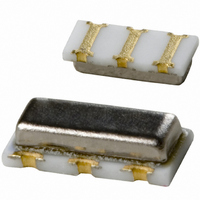CSTCR4M00G53Z-R0 Murata Electronics North America, CSTCR4M00G53Z-R0 Datasheet - Page 26

CSTCR4M00G53Z-R0
Manufacturer Part Number
CSTCR4M00G53Z-R0
Description
RESONATOR 4.00MHZ CERAMIC INDUST
Manufacturer
Murata Electronics North America
Series
CERALOCK®, CSTCRr
Type
Ceramicr
Specifications of CSTCR4M00G53Z-R0
Frequency
4MHz
Features
Built in Capacitor
Frequency Stability
±0.2%
Frequency Tolerance
±0.5%
Impedance
60 Ohm
Capacitance
15pF
Operating Temperature
-40°C ~ 125°C
Mounting Type
Surface Mount
Package / Case
3-SMD, Non-Standard
Size / Dimension
0.177" L x 0.079" W (4.50mm x 2.00mm)
Height
0.045" (1.15mm)
Lead Free Status / RoHS Status
Lead free / RoHS Compliant
Other names
490-1217-2
Available stocks
Company
Part Number
Manufacturer
Quantity
Price
Company:
Part Number:
CSTCR4M00G53Z-R0
Manufacturer:
MURATA
Quantity:
240 000
5
Note
• This PDF catalog is downloaded from the website of Murata Manufacturing co., ltd. Therefore, it’s specifications are subject to change or our products in it may be discontinued without advance notice. Please check with our
• This PDF catalog has only typical specifications because there is no space for detailed specifications. Therefore, please approve our product specifications or transact the approval sheet for product specifications before ordering.
sales representatives or product engineers before ordering.
Oscillation rise time means the time when oscillation
develops from a transient area to a steady state
condition, at the time the power of the IC is activated.
With a CERALOCK
reach 90% of the oscillation level under steady state
conditions as shown in Fig. 5-3.
Rise time is primarily a function of the oscillation circuit
design. Generally, smaller loading capacitance, higher
frequency of ceramic resonator, and lower mechanical Q
of ceramic resonator cause a faster rise time. The effect
of load capacitance becomes more apparent as the
capacitance of the resonator decreases.
Fig. 5-4 shows how the rise time increases as the load
capacitance of the resonator increases. Also, Fig. 5-4
shows how the rise time varies with supply voltage.
It is noteworthy that the rise time of the ceramic
resistor is one or two decades faster than a quartz
crystal.
Fig. 5-5 shows comparison of rise time between the two.
24
5
3. Characteristics of Oscillation Rise Time
Characteristics of CERALOCK
Fig. 5-3 Definition of Rise Time
0.9ⅹVp-p
0V
®
, this is defined as the time to
t=0
ON
Rise Time
Time
Vp-p
V
DD
®
Oscillation Circuit
Fig. 5-4 Examples of Characteristics of Oscillation Rise Time
1.00
0.50
1.00
0.50
0
0
Fig. 5-5 Comparison of the Rise Time of
0
( IC: TC74HCU04(TOSHIBA),
CERALOCK
a Ceramic Resonator vs. a Quartz Crystal
IC : TC74HCU04AP(TOSHIBA)
V
↑ 2.0V/div.
→0.1msec./div.
DD
2
Supply Voltage Characteristics
=+5V, C
®
C
: CSACW33M8X51–B0)
L
(C
1
L1
L1
= C
=C
L2
L2
=6pF
) Characteristics
4
10
6
CRYSTAL
(33.868MHz)
CSACW33M8X51–B0
V
C
DD
L
(pF)
V
DD
= +5V
(V)
100
8
P17E.pdf
10.8.3






















